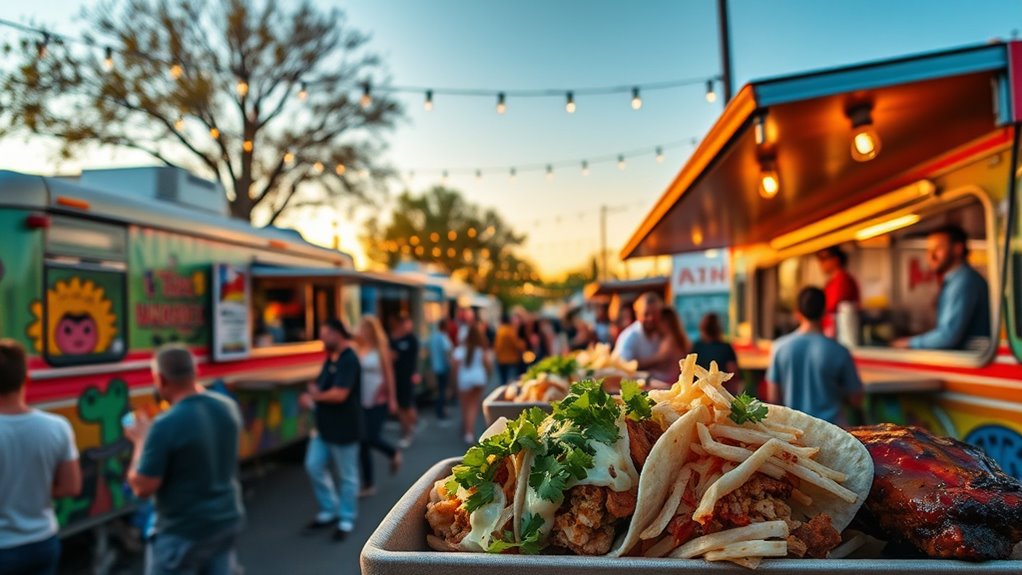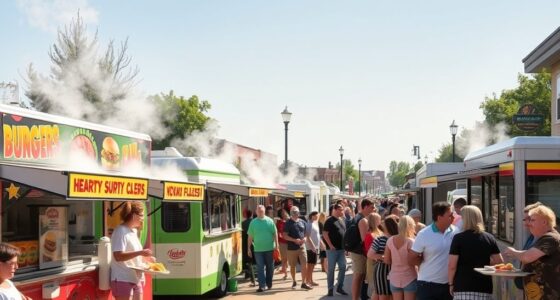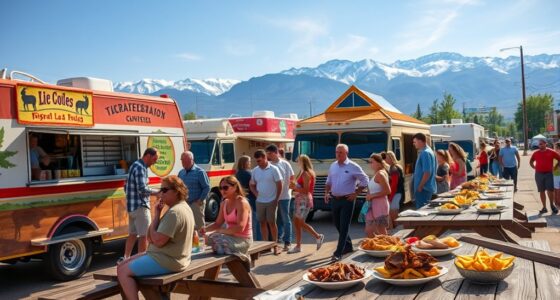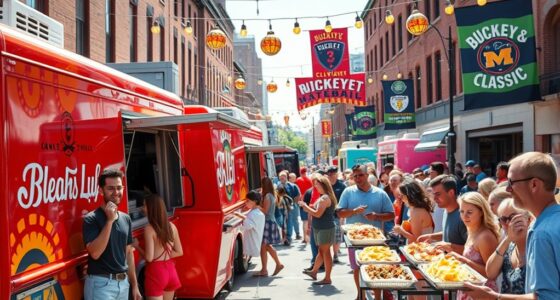In Austin, food trucks serve up fantastic Tex-Mex and BBQ delights that blend tradition with modern twists. You’ll find vibrant Tex-Mex trucks offering tacos, sandwiches, and fusion dishes, often made with authentic local flavors and innovative techniques. Meanwhile, BBQ trucks impress with space-efficient smoking methods and bold flavors from hardwoods like mesquite and oak. If you want to discover the latest trends, popular spots, and secrets behind Austin’s thriving food truck scene, keep exploring what makes these trucks stand out.
Key Takeaways
- Austin hosts over 160 food trucks specializing in authentic Tex-Mex and innovative BBQ, supported by city-friendly regulations and affordable costs.
- Tex-Mex trucks feature signature dishes like tacos and sandwiches, often priced around $18, with fusion options gaining popularity.
- BBQ trucks utilize space-efficient smoking techniques, blending traditional methods with modern equipment for rich, smoky flavors.
- Food trucks incorporate advanced tech such as AI-powered POS, contactless ordering, and real-time marketing to enhance customer experience.
- Media coverage, social media presence, and awards significantly boost visibility and success for Austin’s Tex-Mex and BBQ food trucks.
The Rise of Tex-Mex Food Trucks in Austin
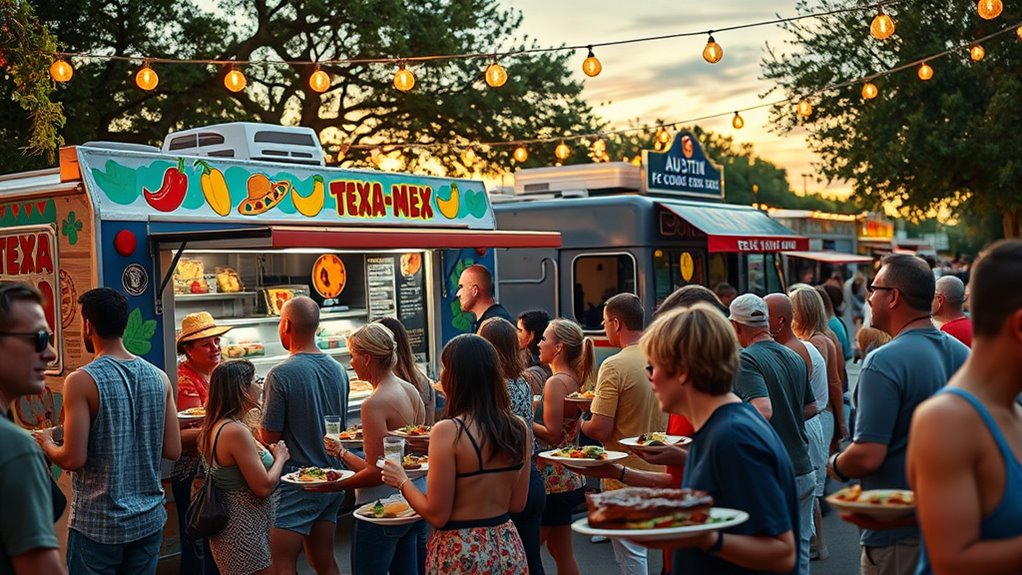
The rise of Tex-Mex food trucks in Austin reflects the city’s dynamic culinary scene and entrepreneurial spirit. Despite the COVID-19 pandemic, the number of food trucks increased from 142 in early 2020 to 161 by early 2021. Food trucks recovered faster than full-service restaurants, boosting workforce numbers from 590 to 638 employees. Travis County now ranks second nationwide for food truck numbers, highlighting Austin’s vibrant mobile dining scene. The city’s affordability, supportive regulations, and food truck-friendly attitude—ranking seventh nationally—fuel this growth. Consumers favor savory Tex-Mex dishes, especially tacos and sandwiches, with average prices around $18. The city’s diverse population and cultural influences also contribute to the popularity of Tex-Mex cuisine. These trucks serve diverse clientele, including corporate events and weddings, making them essential to Austin’s culinary identity and local economy.
Signature BBQ Styles and Techniques on Wheels
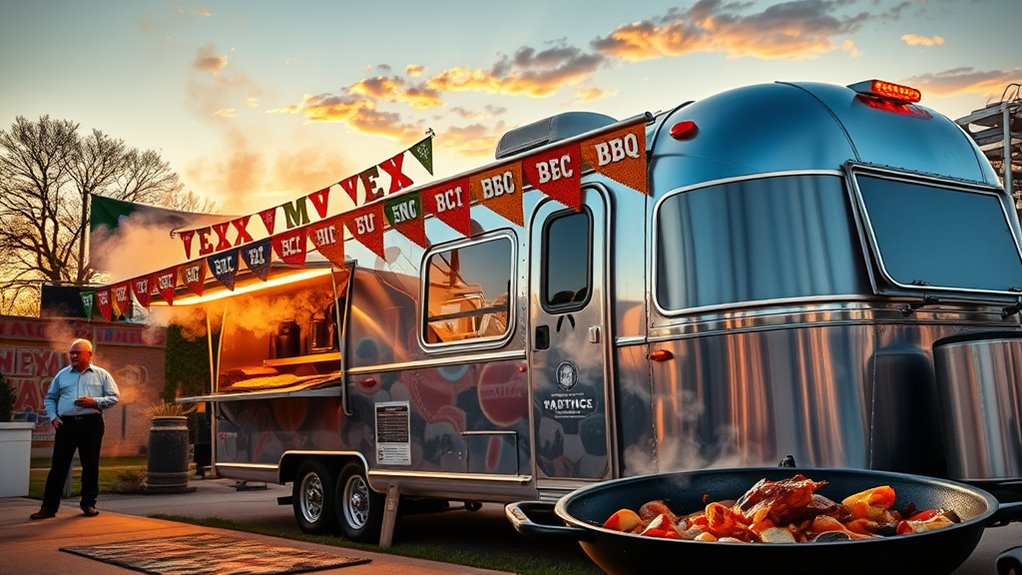
Mobile BBQ in Austin combines traditional smoking techniques with innovative adaptations for limited space, resulting in distinctive flavors and textures. You’ll see offset smokers, or stick burners, adapted to truck chassis for indirect low-and-slow smoking at 225–275°F, creating classic bark and smoke rings. Compact pellet or vertical smokers save space and offer precise temperature control, perfect for high-volume events. Hardwood choices like oak and mesquite balance smoke flavor, depending on the meat. Cold-smoking or smoke-infusing techniques add smoky toppings when space is tight. Hybrid fuel strategies, blending charcoal, wood, or propane, speed up heat recovery while preserving authentic profiles. These methods allow you to serve flavorful, tender BBQ on wheels, blending Texas tradition with modern efficiency. Space-efficient smoking equipment is essential for mobile operations, enabling quick setup and consistent results in confined environments. Incorporating financial management principles can help operators optimize costs and maximize profitability in tight spaces.
Trends Shaping Food Truck Operations in 2025
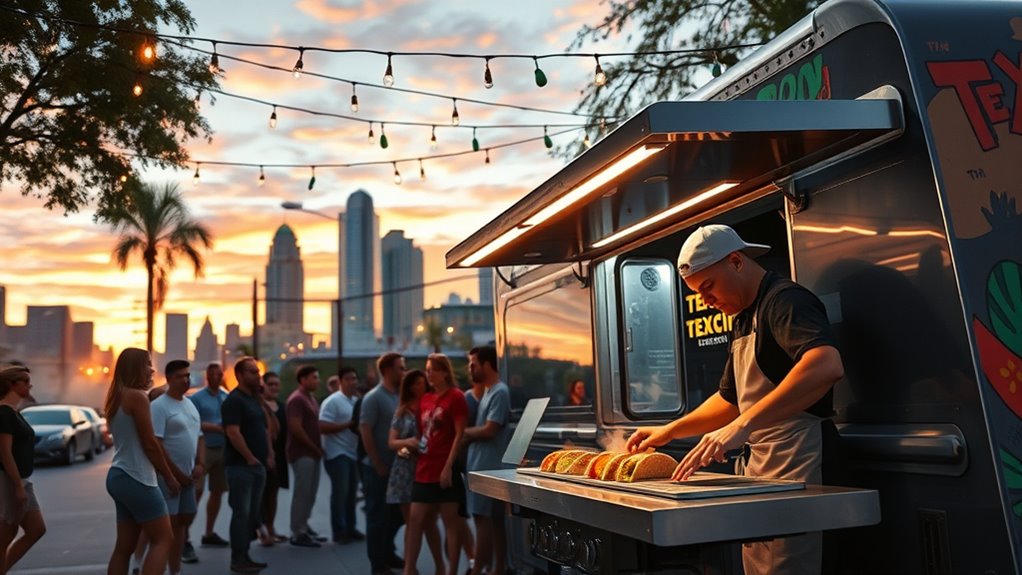
In 2025, food truck operations are increasingly driven by technological and sustainable innovations that reshape how vendors serve customers and manage their businesses. You’ll see AI-powered POS and kitchen management systems reducing labor costs by around 20%, while predictive inventory ordering minimizes waste. Contactless and QR-based ordering, with accuracy rates of 83–88%, streamline peak service times. Real-time location marketing via geofencing and mobile apps boosts event sales and visibility. Energy shifts are prominent—many trucks switch to electric or hybrid powertrains, cutting fuel costs by 15%, with solar arrays and off-grid systems lowering emissions. Eco-friendly packaging and local sourcing meet rising consumer demand for sustainability. Additionally, new revenue models like catering contracts, virtual brands, and merchandise diversify income streams, ensuring more resilience in a rapidly evolving landscape. Incorporating advanced projector technology can also enhance outdoor dining experiences and promotional displays, further attracting customers and increasing revenue.
Consumer Preferences Driving Menu Innovation
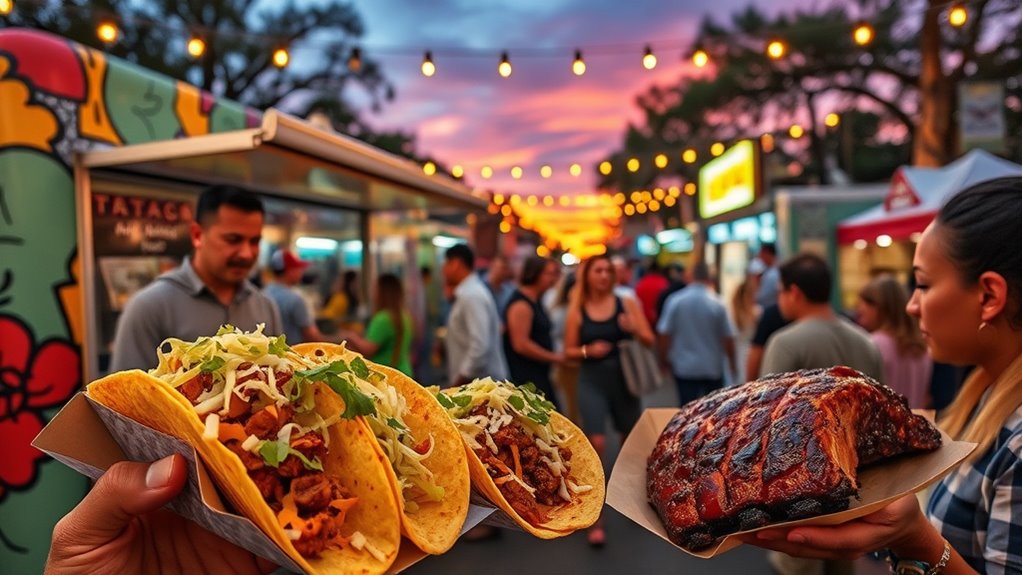
As food truck operations embrace innovative tech and sustainable practices, understanding what customers want becomes vital for menu success. You’ll notice a shift toward authentic regional Tex-Mex flavors like slow-smoked brisket, salsa verde, and traditional preparations that emphasize provenance and technique. Consumers also crave inventive fusion dishes, such as brisket tacos and barbecue queso, for bold, Instagrammable flavors. Spicy, smoky profiles with house-made rubs and chiles are increasingly popular. To meet diverse needs, customizable options—mild to fiery, vegan, or gluten-free—are essential. Health-conscious choices like plant-based proteins, lighter sauces, and veggie-forward plates cater to dietary restrictions. Clear ingredient labeling and transparent pricing help reduce purchase hesitation, ensuring your menu appeals to a broad, value-seeking audience. Incorporating drivetrain components that are easy to maintain and repair can also be a selling point for sustainability-minded customers. Tech-driven ordering & payments streamline the customer experience, enabling quick, contactless transactions that meet modern expectations.
How Media and Recognition Boost Food Truck Success
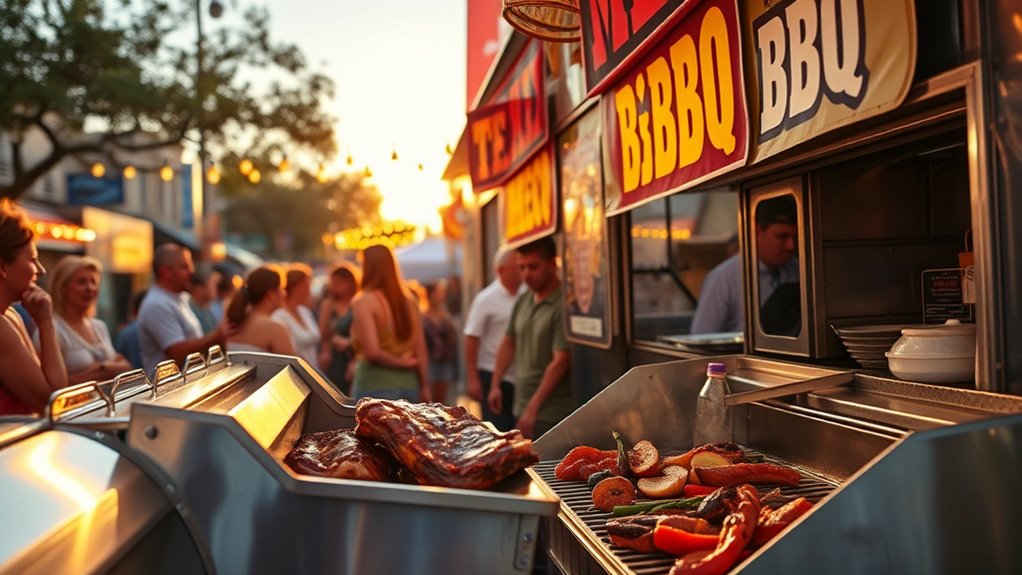
Media and recognition play crucial roles in boosting the success of Austin’s food trucks by increasing their visibility and credibility. Social media like Instagram and Facebook help you reach a wider audience quickly, while online reviews and user content build trust. Coverage from local and national outlets, including festivals, transforms small trucks into citywide sensations. Celebrity endorsements and viral dishes attract attention and foot traffic. Recognition from awards, high ratings on Yelp or Google, and festival wins elevate your status, leading to more media coverage and sponsorships. Incorporating strategic content clusters can further enhance your online authority and sustain long-term growth.
Frequently Asked Questions
How Do Food Trucks Maintain Consistent Quality Across Different Locations?
You maintain consistent quality across different locations by implementing strict operational standards, such as calibrated temperature controls and regular cleaning protocols. You use food safety software to track and document inspections, guaranteeing compliance and quick corrective actions. Active supervision and ongoing staff training help uphold hygiene and safety standards. By following HACCP principles and leveraging technology, you ensure every truck delivers the same high-quality, safe food experience to your customers.
What Are the Typical Startup Costs for a Tex-Mex or BBQ Food Truck?
You’ll need around $50,000 to $200,000 for a new custom Tex-Mex or BBQ food truck, including buildout and equipment. Used trucks cost less, roughly $20,000–$95,000, but may need retrofitting. Expect $450–$3,000 for permits and licenses in the first year. Initial inventory costs about $2,000–$5,000, plus monthly expenses for commissary, fuel, insurance, and marketing. Additional costs for specialty equipment can raise your startup budget further.
How Do Food Trucks Handle Food Safety and Sanitation Regulations in Austin?
You handle food safety and sanitation regulations in Austin by ensuring your truck meets local health standards through regular inspections. You must demonstrate proper water access, waste disposal, refrigeration, and food handling practices, either via a commissary or independently if allowed. During inspections, whether scheduled or surprise, you show compliance. Keeping detailed records and following sanitation protocols helps you pass inspections and maintain your permit, ensuring you operate safely and legally.
What Insurance Requirements Are Needed to Operate a Mobile Food Business?
Think of your food truck as a knight in shining armor, protecting both your business and customers. You’ll need general liability insurance to cover injuries and property damage, along with commercial auto coverage for your vehicle. Don’t forget food liability insurance to guard against foodborne illnesses. Additional endorsements for equipment, liquor, or business interruption might be required, and a Certificate of Insurance proves you’re prepared for any unexpected battles.
How Do Food Trucks Successfully Build a Loyal Customer Base in a Competitive Market?
You can build a loyal customer base by offering signature items that encourage repeat orders and maintaining consistent quality. Use social media to share your location and specials, and implement digital loyalty programs to reward frequent visitors. Participate in local events and establish high-traffic, consistent spots to foster habitual visits. Respond promptly to reviews and gather customer feedback to improve and personalize your offerings, ensuring customers keep coming back.
Conclusion
So, next time you chase that elusive food truck, remember—what’s on wheels often leaves a bigger impression than fancy restaurants. In Austin’s vibrant scene, Tex-Mex and BBQ aren’t just meals; they’re a way of life on the move. Ironically, it’s the simplicity of a truck that’s redefining gourmet. So, indulge, snap a pic, and maybe, just maybe, you’ll find yourself craving more than just a quick bite—because in Austin, food trucks rule the city’s heart.
